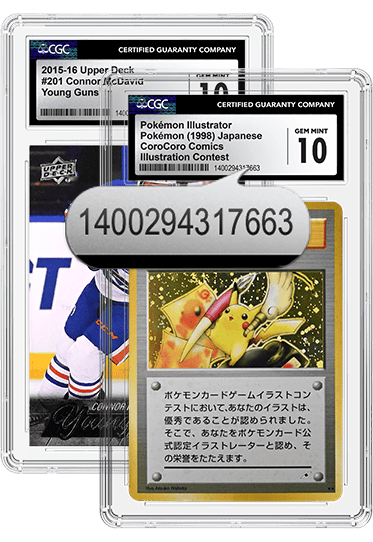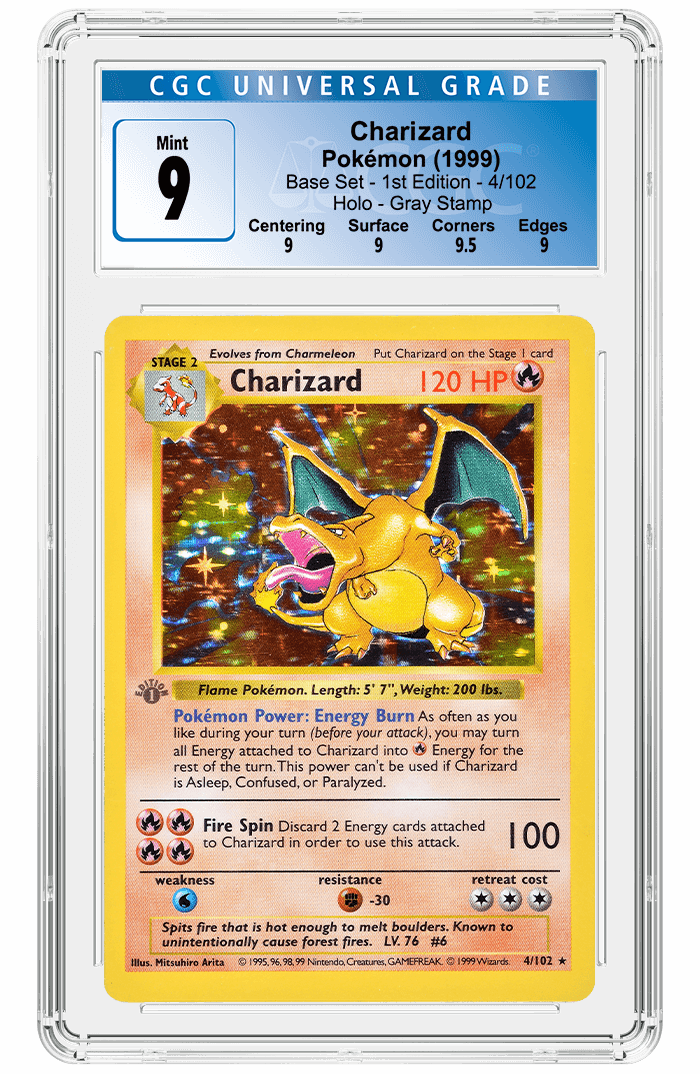Counterfeit Card Alert: 'Ghost' Stamp Error Pikachu
Posted on 6/7/2022
One of the more interesting repeating errors found in the Pokémon Base Set is the so-called “Ghost” Stamp Error Pikachu. These rare cards, which are sometimes found in the gold-strip sealed ZAP! theme decks, feature just a portion of a normal “First Edition” stamp — only the outlines of the letters in EDITION are visible, and the number “1” and the letter “D” are entirely missing. The value of these error cards is on the rise, and as a result, so is the number of fakes. One such counterfeit in the grading room caused CGC Trading Cards™ to further investigate the cause of this error.
How did the “Ghost” Stamp Pikachu error occur?
The cause of “Ghost” Stamp Pikachu error has been a mystery, but CGC Trading Cards can now reveal how the error might have occurred, thanks to former Wizards of the Coast (WotC) Lead Typesetter Christopher Nitz. (Nitz even speculates that he may have been the one to unintentionally let this error slip by!)
According to Nitz, while this variant is colloquially named the “Ghost” Stamp error, the design element printed on these cards is, in fact, an artifact of the printing process known as a “trap.” Essentially, traps are used in offset printing to make sure that slight variations in registration do not affect the overall look of the print itself by overlapping some of the colors.
In the photo above, this first edition stamp from the same era appears to be made of two different layers of black ink. However, the outline around some of the letters is actually a trap that is slightly misplaced on the printing plate. On the “Ghost” Stamp error, the filled in parts of the design are missing, leaving only the hollow trap behind.
Nitz explained that the first edition stamps were printed onto the cards after the rest of the CMYK process, using a separate printing plate loaded into the same press. This is why, especially on First Edition Base Set cards, the stamp is almost always in the same place.
What likely happened in the case of the “Ghost” stamp is that when the CMYK plates were being created, the trap part of the design for the first edition stamp that normally would have been on the additional plate was accidentally included on the regular plates for at least one of the Pikachu cards on the sheet.
Therefore, even without the separate first edition plate, each of these Pikachu cards will show this partial first edition stamp. Only the Base Set Shadowless Pikachu cards from this specific deck are known to have this error, so it is likely that the error only affected the plates for this deck.
Nitz thinks that a similar error during the conversion of the card data in the computer onto the actual plates may also be responsible for the “3D” effect that some first edition stamps display: “The vendor we used for that set of film negatives may have used some sort of auto-trapping software that could distort the trap versus the art.”
What is the value of a “Ghost” Stamp Pikachu?
Because this error is on cards featuring one of the most popular Pokémon, it adds to their value and allure. For an idea of the added value of this variant, a “Ghost” Stamp Error graded CGC 8 sold for $900 on eBay in May 2022, whereas a non-error example in the same grade is currently only worth around $25! With such a large value increase resulting from only a minor change to the card, forgers have recently targeted this rare variant.
How did CGC Trading Cards identify the fake?
This card was recently submitted to CGC Trading Cards for grading. While at first glance, it certainly appears to be a rare “Ghost” Stamp error, it is in fact a normal Shadowless Pikachu with a fake stamp imitating the error added to it!
In the images below, the stamp on the altered card looks decent, even at this close range, except for the stamp’s placement. Because the first edition stamps for Base Set were on a printing plate loaded into the same printer producing the cards, the location of the stamp is very consistent. The middle of the “T” in EDITION should always line up with the bottom-left corner of the art box. In the case of the fraudulent stamp, it is placed too far to the left.
 |
 |
| Close-up images of a genuine "Ghost" Stamp Pikachu (left) and the forged stamp example (right). Click images to enlarge. |
|
With a closer look, the differences between the two stamps becomes even more apparent. At this level of magnification, the quality of the forged stamp is quite obviously inferior. The lines are clear and crisp in the genuine example, while the forgery appears mottled, with blurred edges, and there is even some overspray.
 |
 |
| A genuine example (left) and the forged stamp (right) at increased magnification. Click images to enlarge. |
|
Also, note the shape of the “O”, which is made up of straight-line segments on the genuine stamp but is rounded on the fake. This difference in shape and print quality is due to the types of printers used. While the printing companies making Pokémon cards are using school bus-sized offset-lithography commercial printers, this forger was likely using something in their own home like an Inkjet or Laser printer that simply cannot print to the same quality. This difference in quality is even more apparent under infrared lighting.
 |
 |
| A genuine example (left) and the forged stamp (right) under infrared lighting. Click images to enlarge. |
|
Under infrared lighting, the yellow and red dots that make up the printing of the background of the card fade away, and the structure of the card stock and the black ink can be seen. Note how incredibly crisp the genuine stamp is, whereas the exact opposite can be said of the forgery. Also, the area around the stamp on the forgery is covered in small black specks of ink from being run through a printer to add the stamp. This would never be seen on a genuine card, nor would the broken and incomplete letters of the stamp.
In addition to this altered card, CGC Trading Cards’ expert graders have noted a significant uptick in added regular first edition stamps on WotC era cards, and some of these forgeries can be quite deceptive. It is always important to be vigilant when buying raw high-value cards that are only more valuable due to a small difference like a first edition stamp. Every card certified by CGC Trading Cards is guaranteed to be authentic and accurately graded.
Stay Informed
Want news like this delivered to your inbox once a month? Subscribe to the free CGC eNewsletter today!



 TB20220606165907196.png)
 TB20220606171158735.png)

